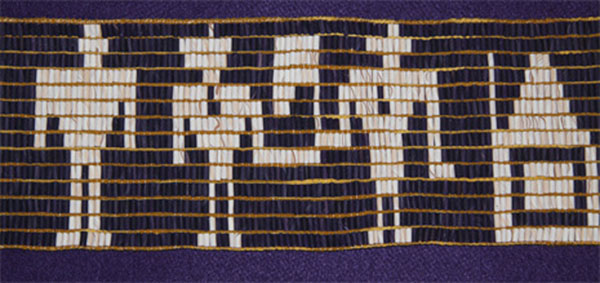 |
 |
 |
Photographs (left to right): Mt. Charleston, California; Queen Anne's Lace, Rush, New York; Great Horned Owl, California
Wampum Belt Archive
Cabins of the Confederacy Belt

Beauchamp 1901, Plate 24, Figure 268



Reproduction (Hamell, Dec. 2012)
Thanks to Rick Hill, Six Nations, for providing high quality photographs of the original belt
which facilitated an accurate reproduction.
Original Size: |
Rows: 14. Width: 4 inches. Length: 41 inches. 238 rows. |
Reproduction: |
Beaded Length: 59.0 inches. Width: 6.5 inches. Length with fringe: 83.0 inches. |
Beads: |
Rows: 347 by 14 beads wide. Total beads: 4,858. |
Materials: |
Warp: leather. Weave: artificial sinew. |
Description:
Beauchamp reported this belt being in the National Museum in Washington, D.C. (1901). The belt was obtained by W. N. Thompson, Chatham, Canada. The beads are mostly dark and rather variable in thickness. One white bead in the outside row is 3/8 inch long, but most are less than a quarter of an inch. The thongs are of plain buckskin. It is said to have belonged to Tecumseh, and this seems not improbable. On the other hand Andrew John, a Cattaraugus Seneca, made this note on it, which is preserved at Washington:
Wampum belt of the Iroquois Indians. This shows the formation of the confederacy called the Five Nations. The five figures of men represent the five tribes of this people as united to form a government of the league. The right hand wigwams are supposed to be the western end of their territory, and the first man to the right represents the Seneca, the doorkeeper to the league, the second the Cayuga tribe, the third the Oneida, the fourth the Mohawk, and the fifth the Onondaga. The first house is the council house, the next five are the original wigwams of the Five Nations, the seventh or last house is the one added to the confederacy, or the Tuscarora tribe, now known as the Iroquois confederacy.
This is rather fanciful, and the Iroquois are fond of referring all they can to the foundation of the league. There are actually eight houses on the belt, which may be read in reverse order, being alike on both sides. Two houses are broader than those at the other end of the belt, made in a different way and without pinnacle. They are not united. Three figures of men next these stand apart and are nations not in alliance as yet, though this may be sought. Two joining hands and supporting a flag between them are in active alliance, and may be the British and Shawnees. Six cabins united by a basal line may be the Six Nations, whose alliance is sought. They are distinguished from those at the other end by side pinnacle, which may be chimneys, indication their advanced condition. This is partly conjectural, but would agree with the supposed history of the belt (Beauchamp, 1901, pp. 408-409).
Alan Corbiere (2018): I usually look to this "Great Wampum Belt of Union" (Catalogue # E165103-0 at NMNH Smithsonian) which is attributed to Tecumseh and then to Wendat but I think it really is a belt delivered to the Ottawa at Michilimackinac after Jay's Treaty. The two wigwams at the one end represent the two Odawa villages. The "house" beside the one fellow is supposedly Fort Michilimackinac then the other house at the other end is the "new" fort at St. Joseph's Island. So to me, these pointed structures are forts, the rounded are wigwams. I do not know why the roof is solid as opposed to the others though. This belt was delivered in 1797 or 1798, I'd have to double check (if it is the belt I suspect it is. (I am currently writing a paper on this; personal communications 2018).
Reference:
Bardeau, Eileen Wms., Edited by Jaré Cardinal, 2010. Definitive Seneca: It's In The Word by Published by Seneca-Iroquois National Museum.
Beauchamp, William M. 1901. Wampum and Shell Articles Used By The New York Indians. New York State Museum Bulletin No. 41, Vol. 8.







